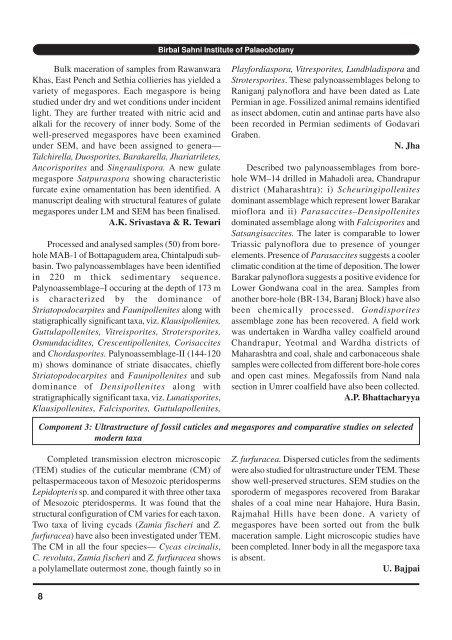Organisational Structure - Birbal Sahni Institute of Palaeobotany
Organisational Structure - Birbal Sahni Institute of Palaeobotany
Organisational Structure - Birbal Sahni Institute of Palaeobotany
You also want an ePaper? Increase the reach of your titles
YUMPU automatically turns print PDFs into web optimized ePapers that Google loves.
<strong>Birbal</strong> <strong>Sahni</strong> <strong>Institute</strong> <strong>of</strong> <strong>Palaeobotany</strong><br />
Bulk maceration <strong>of</strong> samples from Rawanwara<br />
Khas, East Pench and Sethia collieries has yielded a<br />
variety <strong>of</strong> megaspores. Each megaspore is being<br />
studied under dry and wet conditions under incident<br />
light. They are further treated with nitric acid and<br />
alkali for the recovery <strong>of</strong> inner body. Some <strong>of</strong> the<br />
well-preserved megaspores have been examined<br />
under SEM, and have been assigned to genera—<br />
Talchirella, Duosporites, Barakarella, Jhariatriletes,<br />
Ancorisporites and Singraulispora. A new gulate<br />
megaspore Satpuraspora showing characteristic<br />
furcate exine ornamentation has been identified. A<br />
manuscript dealing with structural features <strong>of</strong> gulate<br />
megaspores under LM and SEM has been finalised.<br />
A.K. Srivastava & R. Tewari<br />
Processed and analysed samples (50) from borehole<br />
MAB-1 <strong>of</strong> Bottapagudem area, Chintalpudi subbasin.<br />
Two palynoassemblages have been identified<br />
in 220 m thick sedimentary sequence.<br />
Palynoassemblage–I occuring at the depth <strong>of</strong> 173 m<br />
is characterized by the dominance <strong>of</strong><br />
Striatopodocarpites and Faunipollenites along with<br />
statigraphically significant taxa, viz. Klausipollenites,<br />
Guttulapollenites, Vitreisporites, Strotersporites,<br />
Osmundacidites, Crescentipollenites, Corisaccites<br />
and Chordasporites. Palynoassemblage-II (144-120<br />
m) shows dominance <strong>of</strong> striate disaccates, chiefly<br />
Striatopodocarpites and Faunipollenites and sub<br />
dominance <strong>of</strong> Densipollenites along with<br />
stratigraphically significant taxa, viz. Lunatisporites,<br />
Klausipollenites, Falcisporites, Guttulapollenites,<br />
Playfordiaspora, Vitresporites, Lundbladispora and<br />
Strotersporites. These palynoassemblages belong to<br />
Raniganj palyn<strong>of</strong>lora and have been dated as Late<br />
Permian in age. Fossilized animal remains identified<br />
as insect abdomen, cutin and antinae parts have also<br />
been recorded in Permian sediments <strong>of</strong> Godavari<br />
Graben.<br />
N. Jha<br />
Described two palynoassemblages from borehole<br />
WM–14 drilled in Mahadoli area, Chandrapur<br />
district (Maharashtra): i) Scheuringipollenites<br />
dominant assemblage which represent lower Barakar<br />
mi<strong>of</strong>lora and ii) Parasaccites–Densipollenites<br />
dominated assemblage along with Falcisporites and<br />
Satsangisaccites. The later is comparable to lower<br />
Triassic palyn<strong>of</strong>lora due to presence <strong>of</strong> younger<br />
elements. Presence <strong>of</strong> Parasaccites suggests a cooler<br />
climatic condition at the time <strong>of</strong> deposition. The lower<br />
Barakar palyn<strong>of</strong>lora suggests a positive evidence for<br />
Lower Gondwana coal in the area. Samples from<br />
another bore-hole (BR-134, Baranj Block) have also<br />
been chemically processed. Gondisporites<br />
assemblage zone has been recovered. A field work<br />
was undertaken in Wardha valley coalfield around<br />
Chandrapur, Yeotmal and Wardha districts <strong>of</strong><br />
Maharashtra and coal, shale and carbonaceous shale<br />
samples were collected from different bore-hole cores<br />
and open cast mines. Megafossils from Nand nala<br />
section in Umrer coalfield have also been collected.<br />
A.P. Bhattacharyya<br />
Component 3: Ultrastructure <strong>of</strong> fossil cuticles and megaspores and comparative studies on selected<br />
modern taxa<br />
Completed transmission electron microscopic<br />
(TEM) studies <strong>of</strong> the cuticular membrane (CM) <strong>of</strong><br />
peltaspermaceous taxon <strong>of</strong> Mesozoic pteridosperms<br />
Lepidopteris sp. and compared it with three other taxa<br />
<strong>of</strong> Mesozoic pteridosperms. It was found that the<br />
structural configuration <strong>of</strong> CM varies for each taxon.<br />
Two taxa <strong>of</strong> living cycads (Zamia fischeri and Z.<br />
furfuracea) have also been investigated under TEM.<br />
The CM in all the four species— Cycas circinalis,<br />
C. revoluta, Zamia fischeri and Z. furfuracea shows<br />
a polylamellate outermost zone, though faintly so in<br />
Z. furfuracea. Dispersed cuticles from the sediments<br />
were also studied for ultrastructure under TEM. These<br />
show well-preserved structures. SEM studies on the<br />
sporoderm <strong>of</strong> megaspores recovered from Barakar<br />
shales <strong>of</strong> a coal mine near Hahajore, Hura Basin,<br />
Rajmahal Hills have been done. A variety <strong>of</strong><br />
megaspores have been sorted out from the bulk<br />
maceration sample. Light microscopic studies have<br />
been completed. Inner body in all the megaspore taxa<br />
is absent.<br />
U. Bajpai<br />
8

















